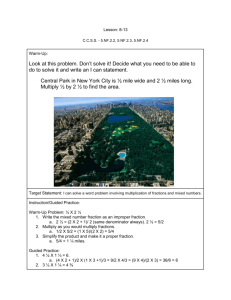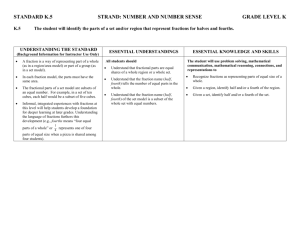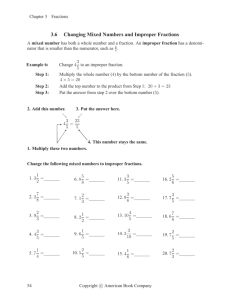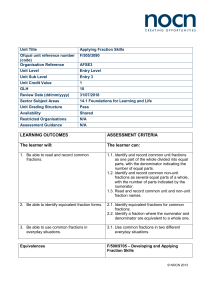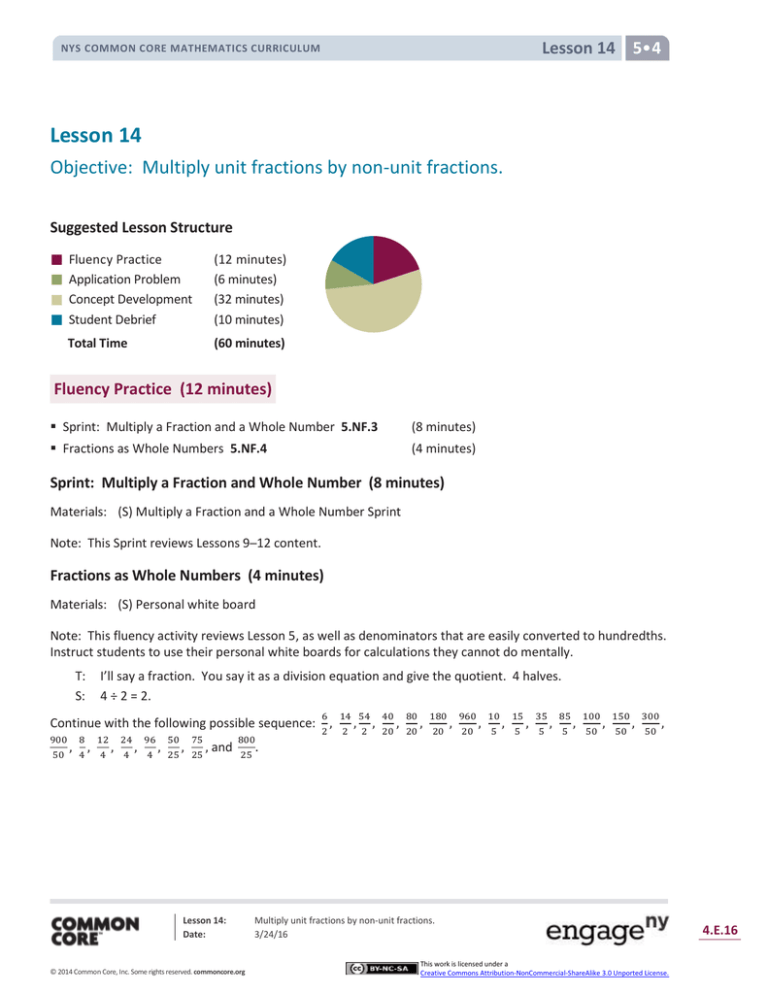
Lesson 14 5 4
NYS COMMON CORE MATHEMATICS CURRICULUM
Lesson 14
Objective: Multiply unit fractions by non-unit fractions.
Suggested Lesson Structure
Fluency Practice
Application Problem
Concept Development
Student Debrief
Total Time
(12 minutes)
(6 minutes)
(32 minutes)
(10 minutes)
(60 minutes)
Fluency Practice (12 minutes)
Sprint: Multiply a Fraction and a Whole Number 5.NF.3
(8 minutes)
Fractions as Whole Numbers 5.NF.4
(4 minutes)
Sprint: Multiply a Fraction and Whole Number (8 minutes)
Materials: (S) Multiply a Fraction and a Whole Number Sprint
Note: This Sprint reviews Lessons 9─12 content.
Fractions as Whole Numbers (4 minutes)
Materials: (S) Personal white board
Note: This fluency activity reviews Lesson 5, as well as denominators that are easily converted to hundredths.
Instruct students to use their personal white boards for calculations they cannot do mentally.
T:
S:
I’ll say a fraction. You say it as a division equation and give the quotient. 4 halves.
4 ÷ 2 = 2.
Continue with the following possible sequence:
900 8 12 24 96 50 75
, ,
, 4 , 4 , 25 , 25 ,
50 4 4
and
800
.
25
Lesson 14:
Date:
© 2014 Common Core, Inc. Some rights reserved. commoncore.org
6 14 54 40 80 180 960 10 15 35 85 100 150 300
,
, ,
,
,
, 20 , 5 , 5 , 5 , 5 , 50 , 50 , 50 ,
2 2 2 20 20 20
Multiply unit fractions by non-unit fractions.
3/24/16
This work is licensed under a
Creative Commons Attribution-NonCommercial-ShareAlike 3.0 Unported License.
4.E.16
Lesson 14 5 4
NYS COMMON CORE MATHEMATICS CURRICULUM
Application Problem (6 minutes)
Solve by drawing a rectangular fraction model and
writing a multiplication sentence.
1
1
Beth had 4 box of candy. She ate 2 of the candy. What
fraction of the whole box does she have left?
Extension: If Beth decides to refill the box, what fraction
of the box would need to be refilled?
Note: This Application Problem stimulates prior
knowledge of the multiplication of unit fractions by unit
fractions in preparation for today’s lesson.
Concept Development (32 minutes)
Materials: (S) Personal white board
Problem 1
3
1
Jan had pan of crispy rice treats. She sent of the treats to school. What fraction of the whole pan did she
5
3
send to school?
T:
S:
(Write Problem 1 on the board.) How is this problem
different than the ones we solved yesterday? Turn and talk.
Yesterday, Jan always had 1 fraction unit of treats. She had
1 half or 1 third or 1 fourth. Today, she has 3 fifths. This
one has a 3 in one of the numerators. We only
multiplied unit fractions yesterday.
T:
In this problem, what are we finding of?
S:
3 fifths of a pan of treats.
T:
Before we find 3 of Jan’s 5 , visualize this. If there are 3
1
3
1
3
1
bananas, how many would 3 of the bananas be? Turn and talk.
S:
Well, if you have 3 bananas, one-third of that is just 1 banana. One-third of 3 of any unit is just
one of those units. 1 third of 3 is always 1. It doesn’t matter what the unit is.
T:
What is 3 of 3 pens?
S:
1 pen.
T:
What is 3 of 3 books?
S:
1 book.
1
1
Lesson 14:
Date:
© 2014 Common Core, Inc. Some rights reserved. commoncore.org
Multiply unit fractions by non-unit fractions.
3/24/16
This work is licensed under a
Creative Commons Attribution-NonCommercial-ShareAlike 3.0 Unported License.
4.E.17
Lesson 14 5 4
NYS COMMON CORE MATHEMATICS CURRICULUM
1
1
T:
(Write = 3 of 3 fifths.) So then, what is 3 of 3 fifths?
S:
1 fifth.
T:
(Write = 1 fifth.) 3 of 3 fifths equals 1 fifth. Let’s draw
a rectangular fraction model to prove your thinking.
3
Draw a rectangular fraction model showing 5.
NOTES ON
MULTIPLE MEANS
OF ENGAGEMENT:
1
S/T: (Draw, shade, and label the rectangular fraction
model.)
1
T:
3
If we want to show 3 of 5, what must we do to each of
these 3 units? (Point to each of the shaded fifths.)
S: Split each one into thirds.
T: Yes, partition each of these units, these fifths, into 3 equal parts.
S/T: (Partition, shade, and label the rectangular fraction model.)
T: To name these parts, what must we do to the rest of the whole?
S: Partition the other fifths into 3 equal parts as well.
T: Show that using dotted lines. What new unit have we created?
S: Fifteenths.
T: How many fifteenths are in the whole?
S: 15.
T: How many fifteenths are double-shaded?
S: 3.
T:
1
3
Consider allowing learners who grasp
these multiplication concepts quickly
to draw models and create story
problems to accompany them. If
there are technology resources
available, allow these students to
produce screencasts explaining
fraction-by-fraction multiplication for
absent or struggling classmates.
3
T:
S:
T:
S:
T:
(Write 3 × 5 = 15 next to the rectangular fraction model.) I thought we said that our answer was 1
fifth. So, how is it that our model shows 3 fifteenths? Turn and talk.
3 fifteenths is another way to show 1 fifth. I can see 5 equal groups in this model. They each
have 3 fifteenths in them. Only 1 of those 5 is double-shaded, so it’s really only 1 fifth shaded here,
too. The answer is 1 fifth. It’s just chopped into fifteenths in the model.
Let’s explore that a bit. Looking at your model, how many groups of 3 fifteenths do you see? Turn
and talk.
There are 5 groups of 3 fifteenths in the whole. I see 1 group that’s double-shaded. I see 2 more
groups that are single-shaded, and then there are 2 groups that aren’t shaded at all. That makes 5
groups of 3 fifteenths.
Out of the 5 groups that we see, how many are double-shaded?
1 group.
1 out of 5 groups is what fraction?
1 fifth.
Does our rectangular fraction model support our thinking from before?
S:
Yes, 3 of 3 fifths equals 1 fifth.
S:
T:
S:
MP.2
1
Lesson 14:
Date:
© 2014 Common Core, Inc. Some rights reserved. commoncore.org
Multiply unit fractions by non-unit fractions.
3/24/16
This work is licensed under a
Creative Commons Attribution-NonCommercial-ShareAlike 3.0 Unported License.
4.E.18
Lesson 14 5 4
NYS COMMON CORE MATHEMATICS CURRICULUM
Problem 2
3
1
Jan had pan of crispy rice treats. She sent of the treats to school. What fraction of the whole pan did she
4
3
send to school?
1
T:
What are we finding 3 of this time?
S:
1
3
of 3 fourths.
1
T:
(Write = 3 of 3 fourths.) Based on what we learned in
the previous problem, what do you think the answer will
1
be for 3 of 3 fourths? Whisper and tell a partner.
S:
Just like 3 of 3 apples is equal to 1 apple, and 3 of 3 fifths
1
1
1
S:
T:
S:
T:
S:
is equal to 1 fifth. We know that 3 of 3 fourths is equal
to 1 fourth. We are taking 1 third of 3 units again.
The units are fourths this time, so the answer is 1 fourth.
Work with a neighbor to solve one-third of 3 fourths.
One of you can draw the rectangular fraction model,
while the other writes a matching number sentence.
(Work and share.)
In your area model, when you partitioned each of the fourths into 3 equal parts, what new unit did
you create?
Twelfths.
How many twelfths represent 1 third of 3 fourths?
3 twelfths.
Say 3 twelfths in its simplest form.
1 fourth.
T:
So, of 3 fourths is equal to what?
S:
1 fourth.
T:
Look back at the two problems we just solved. If 3 of 3 fifths is 1 fifth and 3 of 3 fourths is 1 fourth,
T:
S:
T:
1
3
1
1
1
what then is 3 of 3 eighths?
S:
1 eighth.
T:
1
3
S:
1 tenth.
T:
1
3
S:
1 hundredth.
T:
Based on what you’ve just learned, what is 4 of 4 fifths?
S:
1 fifth.
of 3 tenths?
of 3 hundredths?
1
Lesson 14:
Date:
© 2014 Common Core, Inc. Some rights reserved. commoncore.org
Multiply unit fractions by non-unit fractions.
3/24/16
This work is licensed under a
Creative Commons Attribution-NonCommercial-ShareAlike 3.0 Unported License.
4.E.19
Lesson 14 5 4
NYS COMMON CORE MATHEMATICS CURRICULUM
T:
1
2
S:
1 fifth.
T:
1
4
S:
1 seventh.
of 2 fifths?
of 4 sevenths?
Problem 3:
T:
S:
T:
S:
T:
S:
T:
S:
𝟏 𝟒
×
𝟐 𝟓
We need to find 1 half of 4 fifths. If this were 1
half of 4 bananas, how many bananas would we
have?
2 bananas.
How can you use this thinking to help you find 1
half of 4 fifths? Turn and talk.
It’s half of 4, so it must be 2. This time, it’s 4 fifths, so half would be 2 fifths. Half of 4 is always 2.
It doesn’t matter that it is fifths. The answer is 2 fifths.
It sounds like we agree that 1 half of 4 fifths is 2 fifths. Let’s draw a rectangular fraction model to
confirm our thinking. Work with your partner.
(Draw.)
I notice that our rectangular fraction model shows that the product is 4 tenths, but we said a
moment ago that our product was 2 fifths. Did we make a mistake? Why or why not?
No, 4 tenths is just another name for 2 fifths. I can see 5 groups of 2 tenths, but only 2 of them
are double-shaded. Two out of 5 groups is another way to say 2 fifths.
1
3
6
7
Repeat this sequence with × .
T:
S:
T:
What patterns do you notice in our multiplication
sentences? Turn and talk.
I notice that the denominator in the product is the
product of the two denominators in the factors
before we simplified. I notice that you can just
multiply the numerators, and then multiply the
denominators to get the numerator and
denominator in the final answer. When you
split the amount in the second factor into thirds, it’s like tripling the units, so it’s just like multiplying
the first unit by 3. But, the units become smaller, so you have the same amount that you started
with.
As we are modeling the rest of our problems, let’s see if this pattern continues.
Lesson 14:
Date:
© 2014 Common Core, Inc. Some rights reserved. commoncore.org
Multiply unit fractions by non-unit fractions.
3/24/16
This work is licensed under a
Creative Commons Attribution-NonCommercial-ShareAlike 3.0 Unported License.
4.E.20
Lesson 14 5 4
NYS COMMON CORE MATHEMATICS CURRICULUM
Problem 4
3
4
1
of Benjamin’s garden is planted in vegetables. Carrots are planted in of his vegetable section of the
2
garden. How much of Benjamin’s garden is planted in carrots?
T:
S:
T:
S:
Write a multiplication expression to represent the amount of
his garden planted in carrots.
1 3
× .
2 4
1
3
2 of 4.
1
I’ll write this in unit form. (Write 2 of 3 fourths on the board.)
Compare this problem to the previous ones. Turn and talk.
This one seems trickier because all the others were easy to
halve. They were all even numbers of units. This is half of
3. I know that’s 1 and 1 half, but the unit is fourths, and I
1
don’t know how to say 1 fourths.
2
T:
S:
T:
S:
T:
S:
T:
T:
S:
T:
S:
Could we name 3 fourths of Benjamin’s garden using another
unit that makes it easier to halve? Turn and talk with your
partner, and then write the amount in unit form.
We need a unit that lets us name 3 fourths with an even
number of units. We could use 6 eighths. 6 eighths is the
same amount as 3 fourths and 6 is a multiple of 2.
What is 1 half of 6?
3.
So, what is 1 half of 6 eighths?
3 eighths.
Let’s draw our rectangular fraction model to confirm our thinking. (Allow students time to draw.)
Looking at our model, what was the new unit that we used to name the parts of the garden?
Eighths.
How much of Benjamin’s garden is planted in carrots?
3 eighths.
Problem 5:
T:
T:
S:
𝟑
𝟏
of 𝟐
𝟒
(Post Problem 5 on the board.) Solve this by drawing a rectangular
fraction model and writing a multiplication sentence. (Allow
students time to work.)
Compare this model to the one we drew for Benjamin’s garden.
Turn and talk.
It’s similar. The fractions are the same, but when you draw this one
you have to start with 1 half, and then chop that into fourths.
The model for this problem looks like what we drew for Benjamin’s
Lesson 14:
Date:
© 2014 Common Core, Inc. Some rights reserved. commoncore.org
Multiply unit fractions by non-unit fractions.
3/24/16
This work is licensed under a
Creative Commons Attribution-NonCommercial-ShareAlike 3.0 Unported License.
4.E.21
Lesson 14 5 4
NYS COMMON CORE MATHEMATICS CURRICULUM
garden, except it’s been turned on its side. When we wrote the multiplication sentence, the
factors are switched around. This time, we’re finding 3 fourths of a half, not a half of 3 fourths.
If this were another garden, less of the garden is planted in vegetables overall. Last time, it was 3
fourths of the garden; this time, it would be only half. The fraction of the whole garden that is
carrots is the same, but now, there is only 1 eighth of the garden planted in other vegetables. Last
time, 3 eighths of the garden would have had other vegetables.
T:
1
3
3
1
1
3
3
1
I hear you saying that 2 of 4 and 4 of 2 are equivalent expressions. (Write 2 × 4 = 4 × 2.) Can you give
1
3
an equivalent expression for 2 × 5?
S:
1
2
3
3
1
3
1
T:
S:
Show me another pair of equivalent expressions that involve fraction multiplication.
(Work and share.)
of 5. 5 of 2. 5 × 2.
Problem 6
3
Mr. Becker, the gym teacher, uses 5 of his kickballs in class. Half of the remaining balls are given to students
for recess. What fraction of all the kickballs is given to students for recess?
T:
(Post Problem 6 and read it aloud with
students.) This time, let’s solve using a tape
diagram.
S/T: (Draw a tape diagram.)
T: What fraction of the balls does Mr. Becker use
in class?
S: 3 fifths. (Partition the diagram into fifths and
3
label used in class.)
5
T:
S:
T:
S:
T:
S:
T:
S:
T:
S:
What fraction of the balls is remaining?
2 fifths.
How many of those balls are given to students
for recess?
One-half of them.
What is one-half of 2?
1.
What’s one-half of 2 fifths?
1 fifth.
Write a number sentence and make a statement to answer the question.
1
2
of 2 fifths = 1 fifth. One-fifth of Mr. Becker’s kickballs are given to students to use at recess.
1
3
Repeat this sequence using 3 × 5.
Lesson 14:
Date:
© 2014 Common Core, Inc. Some rights reserved. commoncore.org
Multiply unit fractions by non-unit fractions.
3/24/16
This work is licensed under a
Creative Commons Attribution-NonCommercial-ShareAlike 3.0 Unported License.
4.E.22
Lesson 14 5 4
NYS COMMON CORE MATHEMATICS CURRICULUM
Problem Set (10 minutes)
Students should do their personal best to complete the
Problem Set within the allotted 10 minutes. For some
classes, it may be appropriate to modify the assignment by
specifying which problems they work on first. Some
problems do not specify a method for solving. Students
should solve these problems using the RDW approach
used for Application Problems.
Student Debrief (10 minutes)
Lesson Objective: Multiply unit fractions by non-unit
fractions.
The Student Debrief is intended to invite reflection and
active processing of the total lesson experience.
Invite students to review their solutions for the Problem
Set. They should check work by comparing answers with a
partner before going over answers as a class. Look for
misconceptions or misunderstandings that can be
addressed in the Debrief. Guide students in a
conversation to debrief the Problem Set and process the
lesson.
You may choose to use any combination of the questions
below to lead the discussion.
What is the relationship between Problems 1(a)
and 1(b)? (Part (b) is double Part (a).)
Share and explain your solution for Problem 1(c)
to your partner. Why is taking 1 half of 2 halves
equal to 1 half? Is it true for all numbers? 1 half
6
8
of 6? 1 half of 8? 1 half of 8 wholes?
How did you solve Problem 3? Explain your
strategy to a partner.
What kind of picture did you draw to solve
Problem 4? Share and explain your solution to a
partner.
We noticed some patterns when we wrote our
multiplication sentences. Did you notice the
same patterns in your Problem Set? (Students
should note the multiplication of the numerators
and denominators to produce the product.)
Lesson 14:
Date:
© 2014 Common Core, Inc. Some rights reserved. commoncore.org
Multiply unit fractions by non-unit fractions.
3/24/16
This work is licensed under a
Creative Commons Attribution-NonCommercial-ShareAlike 3.0 Unported License.
4.E.23
Lesson 14 5 4
NYS COMMON CORE MATHEMATICS CURRICULUM
Explore with students the commutative property in real life situations. While the numeric product
1 1 1 1
(fraction of the whole) is the same, are the situations also the same? (For example, × = × .) Is a
3 2 2 3
class of fifth-graders in which half are girls (a third of which wear glasses) the same as a class of fifthgraders in which 1 third are girls (half of which wear glasses)?
Exit Ticket (3 minutes)
After the Student Debrief, instruct students to complete the Exit Ticket. A review of their work will help you
assess the students’ understanding of the concepts that were presented in the lesson today and plan more
effectively for future lessons. You may read the questions aloud to the students.
Lesson 14:
Date:
© 2014 Common Core, Inc. Some rights reserved. commoncore.org
Multiply unit fractions by non-unit fractions.
3/24/16
This work is licensed under a
Creative Commons Attribution-NonCommercial-ShareAlike 3.0 Unported License.
4.E.24
Lesson 14 Sprint 5 4
NYS COMMON CORE MATHEMATICS CURRICULUM
Lesson 14:
Date:
© 2014 Common Core, Inc. Some rights reserved. commoncore.org
Multiply unit fractions by non-unit fractions.
3/24/16
This work is licensed under a
Creative Commons Attribution-NonCommercial-ShareAlike 3.0 Unported License.
4.E.25
Lesson 14 Sprint 5 4
NYS COMMON CORE MATHEMATICS CURRICULUM
Lesson 14:
Date:
© 2014 Common Core, Inc. Some rights reserved. commoncore.org
Multiply unit fractions by non-unit fractions.
3/24/16
This work is licensed under a
Creative Commons Attribution-NonCommercial-ShareAlike 3.0 Unported License.
4.E.26
Lesson 14 Problem Set 5 4
NYS COMMON CORE MATHEMATICS CURRICULUM
Name
Date
1. Solve. Draw a rectangular fraction model to explain your thinking. Then, write a number sentence. An
example has been done for you.
1
Example:
1
2
2
1
of 5 = 2 of 2 fifths = 1 fifth
1
2
1
2
×
2
5
=
2
10
1
=5
2
5
a.
1
3
of 4 = 3 of ____ fourths = ____ fourth
3
1
c.
1
2
of 2 =
e.
1 3
× =
2 5
2
Lesson 14:
Date:
© 2014 Common Core, Inc. Some rights reserved. commoncore.org
b.
1
2
of 5 =
4
d.
2
3
of 2 =
f.
2
3
×4=
1
2
of ____ fifths = ____fifths
1
1
Multiply unit fractions by non-unit fractions.
3/24/16
This work is licensed under a
Creative Commons Attribution-NonCommercial-ShareAlike 3.0 Unported License.
4.E.27
Lesson 14 Problem Set 5 4
NYS COMMON CORE MATHEMATICS CURRICULUM
2.
5
8
of the songs on Harrison’s music player are hip-hop.
1
3
of the remaining songs are rhythm and blues.
What fraction of all the songs are rhythm and blues? Use a tape diagram to solve.
3. Three-fifths of the students in a room are girls. One-third of the girls have blond hair. One-half of the
boys have brown hair.
a. What fraction of all the students are girls with blond hair?
b. What fraction of all the students are boys without brown hair?
1
1
4. Cody and Sam mowed the yard on Saturday. Dad told Cody to mow 4 of the yard. He told Sam to mow 3
of the remainder of the yard. Dad paid each of the boys an equal amount. Sam said, “Dad, that’s not fair!
I had to mow one-third and Cody only mowed one-fourth!” Explain to Sam the error in his thinking.
Draw a picture to support your reasoning.
Lesson 14:
Date:
© 2014 Common Core, Inc. Some rights reserved. commoncore.org
Multiply unit fractions by non-unit fractions.
3/24/16
This work is licensed under a
Creative Commons Attribution-NonCommercial-ShareAlike 3.0 Unported License.
4.E.28
Lesson 14 Exit Ticket 5 4
NYS COMMON CORE MATHEMATICS CURRICULUM
Name
Date
1. Solve. Draw a rectangular fraction model to explain your thinking. Then, write a number sentence.
1
3
3
of 7 =
1
1
2. In a cookie jar, of the cookies are chocolate chip and of the rest are peanut butter. What fraction of all
4
2
the cookies is peanut butter?
Lesson 14:
Date:
© 2014 Common Core, Inc. Some rights reserved. commoncore.org
Multiply unit fractions by non-unit fractions.
3/24/16
This work is licensed under a
Creative Commons Attribution-NonCommercial-ShareAlike 3.0 Unported License.
4.E.29
Lesson 14 Homework 5 4
NYS COMMON CORE MATHEMATICS CURRICULUM
Name
Date
1. Solve. Draw a rectangular fraction model to explain your thinking.
a.
1
2
of 3 = 2 of ____ thirds = ____ thirds
2
1
c.
1
3
of 5 =
e.
1 4
×
3 5
3
=
2. Sarah has a photography blog.
3
7
b.
1
2
4
d.
1
6
of 8
2
f.
4 1
×
5 3
1
of 3 = 2 of ____ thirds = ____ thirds
=
=
of her photos are of nature.
1
4
of the rest are of her friends. What
fraction of all Sarah’s photos is of her friends? Support your answer with a model.
Lesson 14:
Date:
© 2014 Common Core, Inc. Some rights reserved. commoncore.org
Multiply unit fractions by non-unit fractions.
3/24/16
This work is licensed under a
Creative Commons Attribution-NonCommercial-ShareAlike 3.0 Unported License.
4.E.30
Lesson 14 Homework 5 4
NYS COMMON CORE MATHEMATICS CURRICULUM
3
3. At Laurita’s Bakery, 5 of the baked goods are pies, and the rest are cakes.
1
3
of the pies are coconut.
1
6
of
the cakes are angel-food.
a. What fraction of all of the baked goods at Laurita’s Bakery are coconut pies?
b. What fraction of all of the baked goods at Laurita’s Bakery are angel-food cakes?
1
5
4. Grandpa Mick opened a pint of ice cream. He gave his youngest grandchild of the ice cream and his
1
1
middle grandchild of the remaining ice cream. Then, he gave his oldest grandchild of the ice cream
4
3
that was left after serving the others.
a. Who got the most ice cream? How do you know? Draw a picture to support your reasoning.
b. What fraction of the pint of ice cream will be left if Grandpa Mick serves himself the same amount as
the second grandchild?
Lesson 14:
Date:
© 2014 Common Core, Inc. Some rights reserved. commoncore.org
Multiply unit fractions by non-unit fractions.
3/24/16
This work is licensed under a
Creative Commons Attribution-NonCommercial-ShareAlike 3.0 Unported License.
4.E.31

